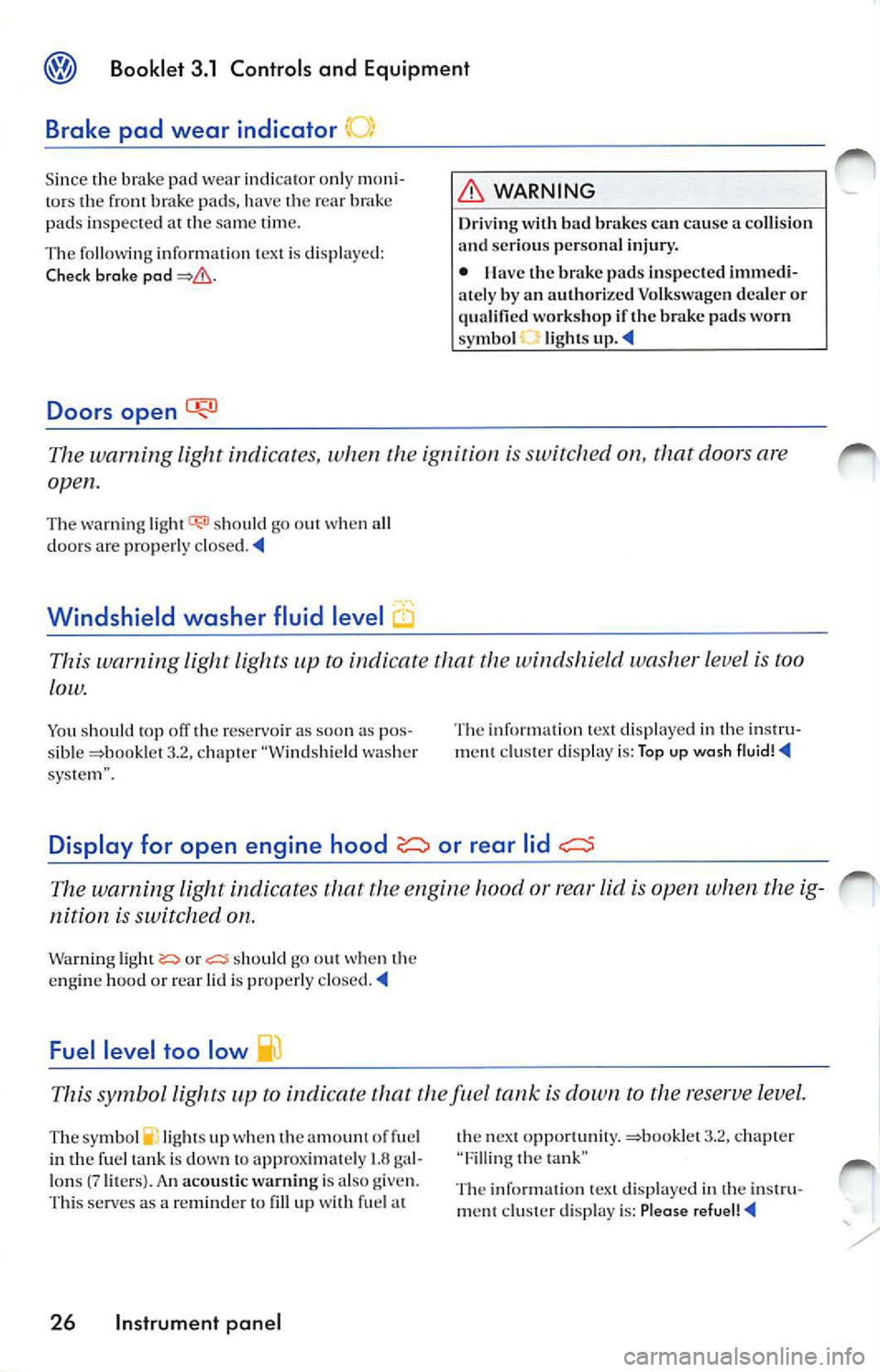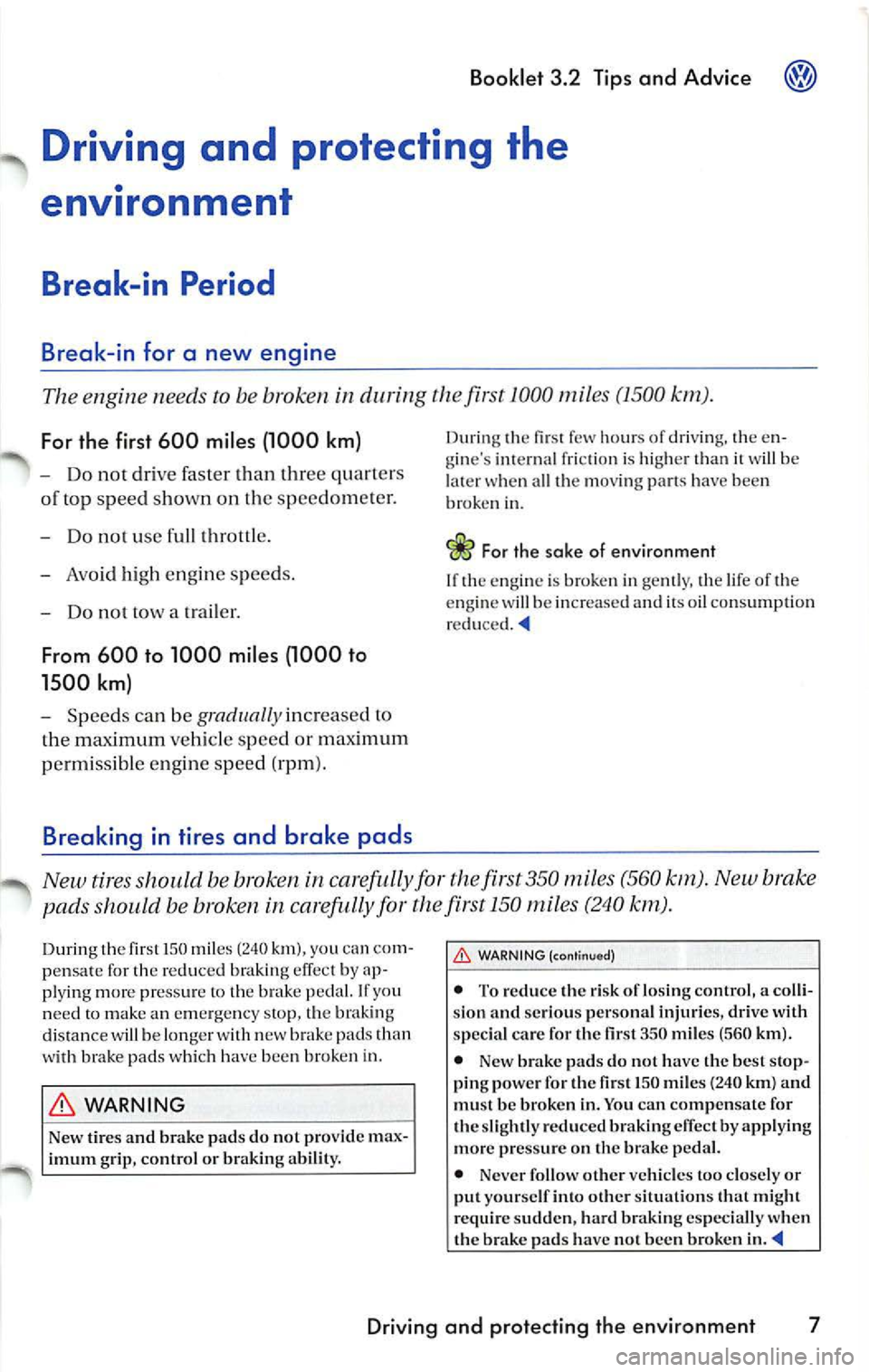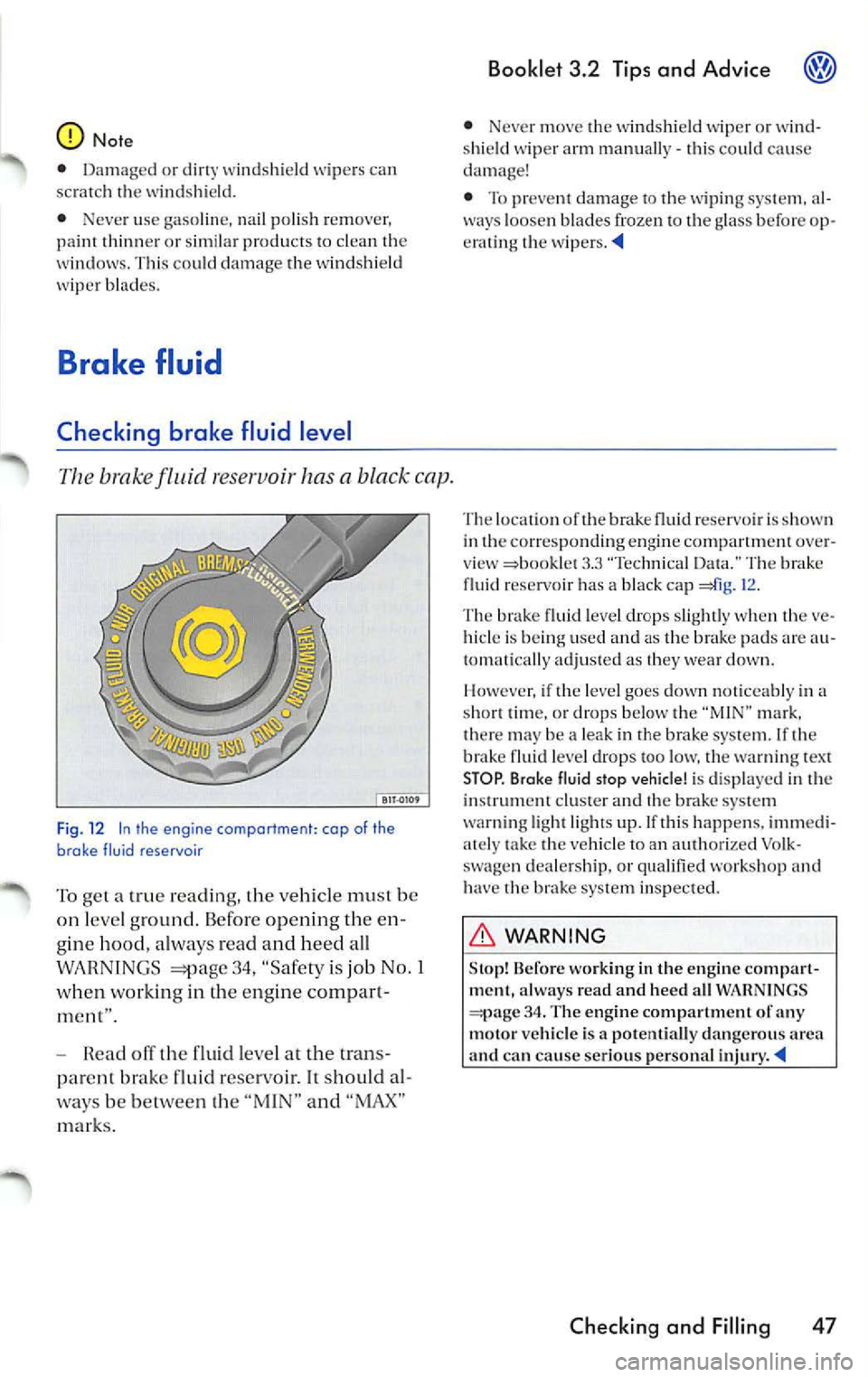2009 VOLKSWAGEN JETTA brake pads
[x] Cancel search: brake padsPage 6 of 477

Automatic belt retractor 2.1: 19
Automatic car washes 3.2: 17
Automatic mode Climatronic 3 .1: 85
A utomatic switch-off of electrica l compo
nents 3.1: 93
A utoma tic transm iss ion
D irec t shif t gearbox 3.1: 98
Safety interlock for ignition key 3.1 : 94
Se lector lever lock 3.1: 99
Tiptro nic 3.1: 98
Automatic transmission with Tiptronic 3.1:
IOI
Average fuel consum ption 3.1: 9
Average speed 3.1: 9
B
Background lighting 3.1: 521
BAS3.2: 2
Batt ery
Charging 3.2: 50
How often should
I replace my engine
battery? 3.2: 50
I m portant information to kn ow before
disconnect the batt ery 3.2: 49
Repla cin g 3.2: 50
What you must do afte r r eco nnect the bat
tery 3.2: 49
Winter condi tions 3.2: 49, 50
Battery acid level
C hec kin g 3.2: 50
Before d riv in g 2.1: 3
Belt pretensioner
Disposa l 2. 1: 26
Serv ice 2.1: 26
Bonnet 3.2: 36
Booster seats 2.1 : 59
Brake assis t sys tem 3.2: 2
Brake booster 3.2: 2
Brak e flu id
C hangin g 3.2: 48
How of ten s hould the brak e fluid be
changed? 3.2: 47
Warning light 3.1: 11
What is the correc t brake fluid level?. 3.2:
47
What kind of brake fluid should
I u se? 3 .2:
48
Booklet 0.1 General Index ®
Brake pad
Warning message 3.1 :
ll
Brak e pad wear indicator
Warn ing light 3.1: 26
Brak e pads 3.2: 8
Brak e servo 3.2: 8
Brak e system
Warn ing light 3.1: 28
Brake system 3.2: 47
Brakes 3.2: 8
H ow does moisture or road salt aff ec t the
brakes? 3.2: 8
What does it mea n when I fee l a s ligh t vi
bration o n the brake peda l? 3.2: 3
Braking distance 3.2: 8
Br eak-in peri od
Engine 3.2: 7
W hat is the rig h t way to break- in my vehi
cle? 3.2:
7
Breaking in
Brake pads 3.2: 7
Tire s 3.2: 7
Breaking in tires 3.2: 7
Bulb c hange 3.2: 8 1
Bulb defective Warning light 3.1: 24
Bumper Clean ing 3.2: 18
Bumper cover Caut ion w hen parking n ear a parking bar
rier or curb 3.1: 105
B uzzer 3.1: 50, 93
C
Ca libratin g the co mpa ss 3.1 : 18
California Propos ition 65 Wa rning 3.2 : 34 , 49
Car washes 3.2: 17
Cata ly tic converter 3.2:
10
CB radio 3 .2: 29
Ce ll phone 3.2 : 29
Cellu lar phone 3.2: 29
Ce ntral lo cking
I ndiv idua l un locking 3.1 : 34
Ce ntral locking button 3.1: 34
Ce ntral locking syste m 3.1: 34
C han gi ng a bu lb 3.2: 8 1
C hanging a wheel 3.2: 73
Alphabetical inde x 3
Page 229 of 477

Booklet 3.1 Controls and Equipment
Brake pad wear indicator"
Since the brake pad wear indica tor onl y m on i
to rs th e front brak e pad s, h ave the rea r brak e
pad s in spected at che same tim e.
T he fo llowi ng information tex t is dis pla yed:
Check brake pad
Doors
WARNING
Driving with bad brak es can ca use a co llision
a nd ser io us pers onal injur y.
• I -l av e the br ake pad s inspe cted immedi
a te ly by an authori zed Volk swagen d eal er or
qu alifi ed wo rksh op if th e brake pads wo rn
s ymbo l lights
The warning indicates , when th e ign ition is switch ed on , that door s are
op en.
Th e warning sh ou ld go out whe n all
door s are pro perl y closed. •
Windshield washer fluid level
This warnin g light li ghts to indicate windshield washer leve l too
Low.
Yo u sh ou ld to p off th e reservo ir as soo n as pos
s ibl e 3.2 , c h apt er "W indshi eld was her
sys tem". T
he in forma tion text displ aye d in th e in stru
m ent clu ste r di splay is : Top up wash
Display for open engine hood or rear lid
The warning Light indicates that the engine or rea r lid is open when the ig
nition i s switc hed on.
Warn ing sh ould go o ut when th e
e n g in e hood or r ear lid is properly closed. •
Fuel level too low
This symbol li ght s to indicate that Ju.el tank i s down to the rese rve le vel.
The symb ol light s up when th e am oun t of fu el
in ch e fu el t an k is do wn to approx imate ly 1.8 ga l
l o n s (7 licers). A n aco ust ic warnin g is a lso g ive n.
Th is se rves as a remind er
to up with fue l a t
26 Inst rument panel
th e nex t oppor tunity . =boo klet 3 .2, ch ap ter
"F illin g th e tank "
inform atio n tex t d isp layed in th e in stru
m ent clu ster dis p lay is: Please
Page 328 of 477

Booklet 3.2 Tips and Advice
Driving and protecting the
environment
Break-in Period
B reak-in for a new engine
The en gine needs to be broken i n during the first 1000 miles (1500 km ).
For the first 600 miles (1000 km)
- Do n ot dri ve faste r than three q uarters
or top speed shown on th e speedo mete r.
- Do not u se full th rott le .
- Avo id high eng ine speeds.
- Do not tow a tra iler.
From 600 to 1000 miles (1000 to
1500 km)
- Speeds ca n be grad ually increased to
the maximu m vehic le speed or max imum
perm iss ibl e en gine spee d (rpm ).
Breaking in tires and brake pads
Durin g first few hou rs of driv in g, the e n
g ine 's in te rn al fri cti on is hi gh er than it will be
all th e m ov in g pan s ha ve bee n
broken in.
For the sake of en vironment
lfth c engine is brok en i n ge ntl y, the life of the
e ngin e w ill b e in crease d and it s oil cons umptio n
New tires s hou ld be b roken in ca refu lly fo r the first 350 mi les (560 km). New b rake
pads s houl d be broken in ca refu lly fo r
first 150 miles (240
WARNING
Ne w tir es and brak e pad s do no t pro vid e m ax
imum grip , co ntrol or b rakin g abilit y.
W ARNING ( continue d)
• T o reduce th e ris k of los ing co ntrol, a colli
s io n and serious perso nal injuri es, drive w ith
s p ecial car e for the fir st 35 0 mil es (560 km ).
• New brake pads do not have th e be st stop
pin g powe r for the fir st 1 50 mil es (24 0 km) and
mu st b e bro ken in. You ca n comp en sa te for
th e sli ghtl y re du ced brakin g
by apply in g
mor e pr ess ure o n th e bra ke p ed al.
• Never fo llow other vehicle s to o clo sely or
put your se lf into oth er situ ation s th at mi ght
re quir e sudd en, hard br akin g es peci all y w hen
th e b rak e pads have not b ee n brok en
Driving and protecting the environment 7
Page 329 of 477

Booklet 3.2 Tips and Advice
Braking power and braking distance
Braking power and braking distance are influenced by driving situations and
road
Worn brake pads will not provide good braking.
The amount of wear and tear on the brake pads
depends to a great extent on the cond itions
und er which the vehicle is opera ted and the way
the vehicle is dr iven. If you do a lot of city
driv ing, drive short distances or have a sporty
driving style, we reco mm end th at you have the
thickness of your brake pad s checked by an au
thor ized Volkswagen dea ler more frequently
than r ecommend ed in the service schedule.
I f you dr ive witJ1 wet brakes , for example after a
dri ving through water,
heavy rainfall or
after washing the vehicle, brakin g power will be
reduced and sto pping distances w ill be longer
because the brake d iscs will be wet or in winter
ma ybe even frozen
the brakes must be dried
with severa l ca reful brake applications.
Brake fluid absorbs water and must be c hanged
every two years. Heavy use of the brakes can
cause vapor lock if the brake fl uid is too old.
Va por lock reduces braking power, increases
stopp ing distances and can even cause total
brake failure.
WARNING
• New tires and new brake pads do not pro
v id e maximum grip, control or braking abilit y.
• To reduce the risk of losing control, a colli
s ion and se rious persona l injuries, drive with
special ca re for the first
350 mil es (560 km).
• New brake pads do not have the best stop
ping power for the first
150 mil es (240 km) and
must be broken in. You can com pensate for
the slightly reduced braking ability by drivin g
w ith care and applying more pressure on the
brak e pedal.
• Never fo llow other vehicle s too close ly or
put yourse lf into other situ ations that might
r equ ire s udden , hard brakin g especially when
th e brake pads have not been broken in.
WARNING
Wet brake s or brak es coa ted ice or road
sa lt react slower and need longer stopping dis
tanc es.
• Carefully apply brakes for a lest.
• Alwa ys dry brake s and clean olT ice coa t
ings and salt coa tings with a few cautiou s
brake app lica tions.
• Always read and hee d all
in "Break ing in tir es and brake pads" on
page 7.
WARNING
Overheated brakes will reduce the vehicle's
s topping power and increase stoppin g di s
tances.
• Always avoid over hea tin g the brakes!
• When driving downhill, the brakes have to
work hard and hea t up quickly .
• Before driving clown a long, steep hill, al
ways red uce spee d and downshift to a lower
gea r. This will let th e ve hicle use engine
braking and reduce the load on the brakes.
• Always c han ge the brake fluid at least
every two years. Hard braking with old brake
fluid may cause a va por lock. Vapor lock re
duces brakin g power, increases s topping dis
tan ces and can even ca use to tal brake failure.
• A damaged front spoiler or new non stan
dard spoile r ca n reduce the airflo w to the
brake s and cause them to overheat.
• Always sec an au thorized Vo lkswage n
dealer or qualil1ed workshop if yo u think th at
you may have damaged the front spoiler.
• Be sure to read and heed all WARNINGS
and the information =-page 27, "Accessories
and part s" before buying accessorie s.
8 Driving and protecting the environment
Page 368 of 477

fluid reservoir has a black cap.
Fig. 12 I n the engine compartm ent : c ap of the
brake fluid reservoi r
To get a read in g, the ve hicl e be
on leve l g round . Before opening th e
g in e hood, always rea d and hee d all
WA RN INGS
34, "Sa fety is job No. 1
w hen wo rkin g in the eng ine com par t·
m ent' '.
H ead off fluid leve l a t the tran s
par ent brak e fluid reservo ir. IL sho uld
ways be be twee n th e "M IN" and "MAX"
m arks .
Bookl et 3.2 Tips and Advic e @
• Never move the w indshi eld wiper o r sh ield wiper arm manu ally· this co uld cause
damage!
• To prevent damage to the wiping sys te m,
ways loose n blades froze n to th e g lass befor e ting th e wi pers
Th e loca tion of the brak e flu id reservo ir is show n
in the correspo nding engin e co mpartm ent over·
v iew
3 .3 "Tec hnical Data. " T he brake
fluid reservoir has a black cap 12 .
Th e fluid leve l drops slightly w hen th e hide is bein g use d and as the pads are to mat ically a dju ste d as they wea r dow n.
Howe ver, if the leve l goes
no ticeab ly i n a time, o r drops below th e "MIN " mark,
ther e ma y be a lea k in the brake syste m. If th e
brak e fluid leve l drops too low, the wa rnin g tex t
STOP . Brake fluid stop vehicle! i s disp layed i n the
instrumem cluste r an d the brake system
warning lig ht light s up . If this hap pens, imm edi ·
ate ly take the ve hicle to an auth orized Vo lk
s wa gen d ealer ship, or qua lified workshop a nd
have the brak e sys te m insp ecte d.
WARNING
Stop! Before wo rk in g in the en gin e compart
ment , a lways read and h eed all WARN IN GS
34 . Th e engine compar tme nt of any
motor vehicle is a pot entia lly dan gerou s area
and can ca use ser io us perso nal injur y
Checking and Filling 47